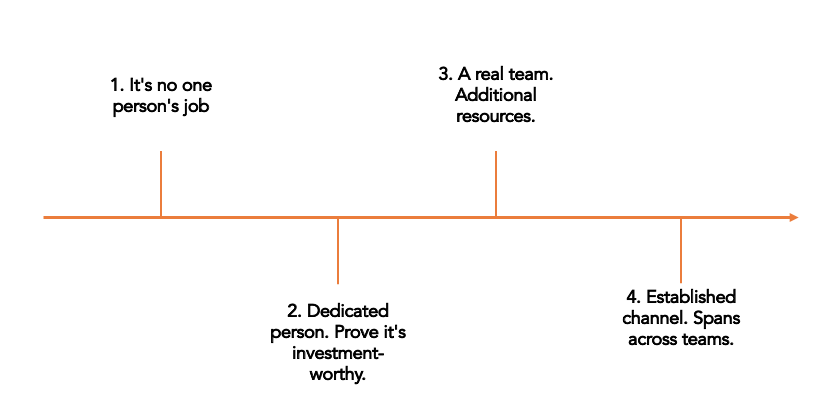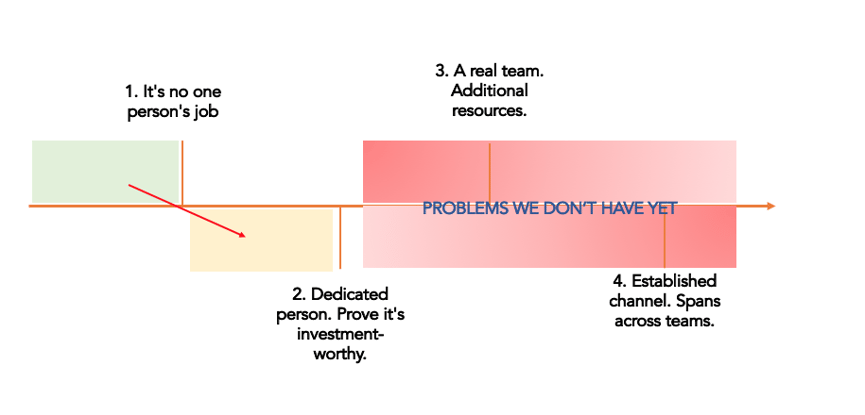In this episode of the GrowthTLDR, we're back with another GrowthSwipeFile.
We talk about the challenges of trying to start something new, whether that's starting a growth team, investing in a new channel, program, or initiative. There is always a list of problems you're faced with when scaling.
We talk about a framework that might help called the four stages of growth. We talk about why it's important to align people around them, so you're solving problems that matter.
Happy Growing!
A critical part of career growth is spending a considerable amount of time with smart people.
It's why I've been fortunate to work at HubSpot; I get to debate topics with people who are world-class at what they do.
Recently Kipp (HubSpot CMO) and I were discussing the challenges of scaling out something new in a fast-growing company and realized that a lot of the reasons companies aren't successful with it is they're stuck solving the wrong problems.
Let me explain :)
If you've been listening to the GrowthTLDR podcast, you've probably heard stories from people about the complexities of starting a growth team, or a new marketing channel, or taking on a new initiative.
Their progress is severely hampered with debates on what metrics are important, what team is responsible for what, how many people should be dedicated to the initiative.
It's because they're often mixing up the stage they're at with the problems worth solving.
There are four stages to growing out something new within a company:

1. It's no one person's job
2. Dedicated person. Prove it's investment-worthy.
3. A real team. Additional resources.
4. Established channel. Spans across teams.
Each stage will bring its own set of problems.
1. It's no one person's job
In high growth companies, people will often be doing a variety of roles, creating some content for the blog, doing some SEO, posting on social, running some paid campaigns, optimizing onboarding flows.
As the company grows, the marketing/growth lead sees opportunity in these channels and wants to know if their investment-worthy.
2. Dedicated person. Prove it's investment-worthy
I hire or move a person internally to be responsible for one of these initiatives, give them clear metrics to be accountable to, and a timeframe to show success against those metrics.
For example, I have someone dedicated to SEO who needs to show they can grow traffic and monetize that traffic. I have someone dedicated to onboarding who can demonstrate they can improve user activation within X months. I have someone dedicated to partnership marketing that can attract a certain amount of referral traffic over six months.
Make sure you have easy to understand success metrics and a clear timeframe to decide if it has been a success or not.
3. A real team. Additional resources.
That person has demonstrated it's something worth investing in; now you need to hire additional resources, consider where the team will sit within the organization, who the manager should be, etc.
4. Established channel. Spans across teams.
At this point, the initiative has become a core part of your growth engine. Responsibility for its success spans across several teams. There are clear guardrails on what each team is responsible for, with clear success metrics and ongoing investment.
Imagine you're currently trying to go from a 1 to a 2. But, your teams are stuck debating problems that will happen once the initiative moves to a 3 or 4.

You're spending time on problems that aren't worth solving, and they're likely slowing you down.
It's not easy to tell a group of smart people not to worry about future problems, but sometimes you need to dumb down the mission to be successful—narrow your focus to the problems associated with the stage.
The above framework for discussing channels/initiatives and their problems have been an enormous help to anchor conversations around what matters.
Your company may differ in terms of stages and the number of them. But, having a shared framework for how to think about growth initiatives, stages, and problems is an excellent way of getting people/teams aligned on what's important.
 iTunes
iTunes Stitcher
Stitcher Spotify
Spotify